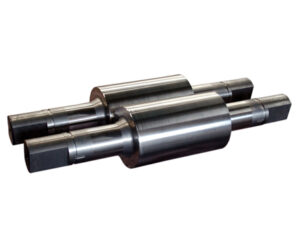ESR Forged Tool Steel Round Roller For Cold Rolling Rolls/Mill/Equipment
Introduce
We manufacture the forged steel for cold rolling equipment. Cold rolling is a forming process which takes place below recrystallization temperature. It involves further reduction of already hot-rolled strip and a determining of the mechanical and technological properties of the same strip. Due to specific requirements during processing, cold rolling is regarded as a speciality within the diverse application areas of cold-work tool steels. They nevertheless have uses in other fields such as back-up rolls, straightening and section-bending rolls.
Application
These materials are used in large machinery in the cold forming of steel, such as cold rolled strip rollers, cold rolled profile rollers, welded tube forming rollers, etc.
The main steps in roll production are:
*Melting, refining, ESR
*Forging
*Heat treatment in one or several steps
*Machining
*Final control
Size
*Max Diameter: 400-1000mm
*Max Length: 6000-14000mm
Chemical Composition
| Grade | C | Si | Mn | P | S | Cr | W | Mo | V | Co | Ni | Cu |
| 1.2379/D2/SKD10 | 1.40-1.60 | 0.60max | 0.60max | 0.03 max | 0.02max | 11.00-13.00 | – | 0.70-1.20 | 0.50-1.10 | 1.00max | – | – |
| 1.2344/H13/SKD61 | 0.35-0.42 | 0.8-1.2 | 0.25-0.5 | 0-0.03 | 0-0.03 | 4.8-5.5 | – | 1.2-1.5 | 0.8-1.2 | / | – | – |
| 1.2714/SKT4/L6 | 0.50-0.6 | 0.1-0.4 | 0.6-0.9 | 0.8-1.2 | 0.35-0.55 | 1.5-1.8 | – | – | – | – | ||
| 1.2327/86CrMoV7 | 0.87 | 0.3 | 0.38 | ≤0.025 | ≤0.025 | 1.75 | – | 0.28 | 0.1 | – | 0.13 | – |
| EN 31 | 0.90-1.20 | 0.10-0.35 | 0.30-0.75 | 0-0.03 | 0-0.03 | 1.00-1.60 | – | – | – | – | – | – |
| 100Cr6 | 0.95-1.05 | 0.15-0.35 | 0.25-0.45 | ≤0.025 | ≤0.025 | 1.4-1.6 | – | – | – | ≤0.25 | ≤0.25 | |
| 9Cr | 0.85~0.95 | 0.25~0.45 | 0.2~0.35 | ≤0.025 | ≤0.025 | 1.4~1.7 | – | – | – | – | ≤0.25 | ≤0.25 |
| 9Cr2 | 0.8~0.95 | ≤0.4 | ≤0.4 | ≤0.03 | ≤0.03 | 1.3~1.7 | – | – | – | ≤1 | – | ≤0.3 |
| 9CrV | 0.85~0.95 | 0.25~0.45 | 0.2~0.45 | ≤0.025 | ≤0.025 | 1.4~1.7 | – | – | 0.1~0.25 | – | – | ≤0.25 |
| 9Cr2W | 0.85~0.95 | 0.25~0.45 | 0.2~0.35 | ≤0.025 | ≤0.025 | 1.7~2.1 | 0.3~0.6 | – | – | – | ≤0.25 | – |
| 9Cr2Mo | 0.85~0.95 | 0.25~0.45 | 0.2~0.35 | ≤0.03 | ≤0.03 | 1.7~2.1 | – | 0.2~0.4 | – | – | ≤0.25 | ≤0.25 |
| 9Cr2MoV | 0.85~0.95 | 0.25~0.45 | 0.2~0.35 | ≤0.025 | ≤0.025 | 1.7~2.1 | – | 0.2~0.3 | 0.1~0.2 | – | ≤0.25 | – |
Smelting Option
1 EAF: Electric Arc Furnace
2 EAF+LF+VD: Refined-smelting and vacuum degassing
3 EAF+ESR: Electro Slag Remelting
4 EAF+PESR: protective atmosphere Electro Slag Remelting
5 VIM+PESR: Vacuum induction melting
Forming Option
1 Hot rolling process
2 Hot Forging: Electro-hydraulic; High-speed-hydraulic; Oil-hydraulic; Precision-forging
Heat-treatment Option
1 +A: Annealed (full/soft/spheroidizing)
2 +N: Normalized
3 +NT: Normalized and tempered
4 +QT: Quenched and tempered (water/oil)
Suface Option
1 Black Surface
2 Grounded: Bright but rough ; Not precision
3 Machining for plate: Bright and precision; Little turning scar
4 Peeled/Turned: Bright and precision; Little turning scar
5 Polished: Very Bright and precision size; Not turning scar
Other Services
1 Cutting: Small pieces
2 CNC Machine: Produce as your drawing
3 Package: Bare/Nylon/Canvas/Wooden
4 Payment:T/T, L/C, O/A(request credit)
5 Transport:FOB/CFR/CIF/DDU/DDP (train/ship/Air)
The mastering of many technologies
At the heart of our products lies excellence in metallurgy expertise, enabling us to develop new grades and assure the manufacture of high quality rolls.
We also require specialist skills from other disciplines, such as machining. Application knowledge, such as rolling and roll maintenance, are also important competencies for the R&D process, as well as providing technical assistance to our customers.
Roll making
Manufacturing rolls requires many different technologies, some that we have developed ourselves, and others that are already available in the marketplace. Our foundries, steel plant, forging, machine, and heat treatment shops, are capable of manufacturing a wide range of rolls. Benchmarking between our plants enables us to establish best practices and ensures that knowledge exchange is efficiently spread throughout the company.
When you consider the challenging environments in which our products are used, the materials and methods that we employ to make our rolls are under high pressure to perform. Add to this the output capacities of today’s high-performance mills, and the fact that operators demand extended roll lifetimes with no degradation in quality, you will see that our task is not an easy one.
Research and Development
our R&D process also includes evaluation on material properties, validation of process and product qualities, in service performance evaluation and follow-up throughout the life span of the product to ensure product quality. The R&D process is based upon a set of predetermined phases which make certain that we can reliably move a new product from design and prototype phases into market launch.

